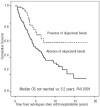Natural history and prognostic impact of oligoclonal humoral response in patients with multiple myeloma after autologous stem cell transplantation: long-term results from a single institution
- PMID: 23645688
- PMCID: PMC3696619
- DOI: 10.3324/haematol.2013.084350
Natural history and prognostic impact of oligoclonal humoral response in patients with multiple myeloma after autologous stem cell transplantation: long-term results from a single institution
Abstract
The emergence of an oligoclonal humoral response, resulting in the appearance of a different serum M-protein to that observed at diagnosis is a well-recognized event after autologous stem cell transplantation in multiple myeloma in complete response, and it has been considered to be a benign phenomenon. The aim of the present study was to investigate the incidence, biological characteristics and prognostic value of the oligoclonal bands in patients with myeloma who underwent autologous transplantation at our institution in the last 18 years. We proceed with a retrospective systematic review of all serum and urine immunofixation studies performed in the 211 patients with multiple myeloma who underwent melphalan-based autologous transplantation. Oligoclonal bands were observed in 34% of the patients, with a significantly higher prevalence with the use of novel agents versus conventional chemotherapy in induction (63% vs. 22%; P=0.0001). The incidence of oligoclonal bands was most frequent in non-IgG isotype, particularly in light chain only myeloma. The oligoclonal phenomenon was almost exclusive to patients in complete remission compared to other degrees of response (87% vs. 13%; P=0.0001), and lasted for a median of 1.35 years, persisting during follow up in all patients except in those who relapsed. In prognostic terms, the presence of oligoclonality resulted in a significantly longer progression-free and overall survival. Patients with oligoclonal humoral response lasting for more than one year after transplantation had a significantly longer clinical progression-free and overall survival than those with shorter duration (P=0.008 and P=0.0001, respectively), likely reflecting the importance of a robust humoral immune response.
Figures
Similar articles
-
Differential humoral responses against heat-shock proteins after autologous stem cell transplantation in multiple myeloma.Ann Hematol. 2014 Jan;93(1):107-11. doi: 10.1007/s00277-013-1942-7. Epub 2013 Nov 12. Ann Hematol. 2014. PMID: 24218189
-
Oligoclonal bands and immunoglobulin isotype switch during monitoring of patients with multiple myeloma and autologous hematopoietic cell transplantation: a 16-year experience.Clin Chem Lab Med. 2010 May;48(5):727-31. doi: 10.1515/CCLM.2010.050. Clin Chem Lab Med. 2010. PMID: 20450334
-
For survival, the emergence of oligoclonal bands after multiple myeloma treatment is less important than achieving complete remission.Rev Bras Hematol Hemoter. 2017 Oct-Dec;39(4):331-336. doi: 10.1016/j.bjhh.2017.05.010. Epub 2017 Jul 1. Rev Bras Hematol Hemoter. 2017. PMID: 29150105 Free PMC article.
-
[Complete remission of nephrotic syndrome and improvement of renal function in a patient with light chain deposition disease following high dose chemotherapy with transplantation of autologous haematopoietic stem cells. A case study and review of literature].Vnitr Lek. 2009 Nov;55(11):1089-96. Vnitr Lek. 2009. PMID: 20017442 Review. Czech.
-
The role of high-dose chemotherapy in the treatment of multiple myeloma: a controversy.Ann Oncol. 2000;11 Suppl 1:55-8. Ann Oncol. 2000. PMID: 10707780 Review.
Cited by
-
Emergence of Oligoclonal Bands in Association with the use of Chemotherapy and Hematopoietic Stem Cell Transplantation.Indian J Clin Biochem. 2022 Jul;37(3):328-334. doi: 10.1007/s12291-021-00983-0. Epub 2021 May 19. Indian J Clin Biochem. 2022. PMID: 35873608 Free PMC article.
-
Immunoparesis recovery in newly diagnosed transplant ineligible multiple myeloma patients, an independent prognostic factor that complements minimal residual disease.Ann Hematol. 2024 Dec;103(12):5651-5661. doi: 10.1007/s00277-024-06031-0. Epub 2024 Oct 23. Ann Hematol. 2024. PMID: 39438321
-
B-Cell Regeneration Profile and Minimal Residual Disease Status in Bone Marrow of Treated Multiple Myeloma Patients.Cancers (Basel). 2021 Apr 3;13(7):1704. doi: 10.3390/cancers13071704. Cancers (Basel). 2021. PMID: 33916787 Free PMC article.
-
New criteria for response assessment: role of minimal residual disease in multiple myeloma.Blood. 2015 May 14;125(20):3059-68. doi: 10.1182/blood-2014-11-568907. Epub 2015 Apr 2. Blood. 2015. PMID: 25838346 Free PMC article. Review.
-
Critical analysis of the stringent complete response in multiple myeloma: contribution of sFLC and bone marrow clonality.Blood. 2015 Aug 13;126(7):858-62. doi: 10.1182/blood-2015-04-638742. Epub 2015 Jun 18. Blood. 2015. PMID: 26089396 Free PMC article. Clinical Trial.
References
-
- Dimopoulos M, Kyle R, Fermand JP, Rajkumar SV, San Miguel J, Chanan-Khan A, et al. Consensus recommendations for standard investigative workup: report of the International Myeloma Workshop Consensus Panel 3. Blood. 2011;117(18): 4701–5 - PubMed
-
- Bladé J, Samson D, Reece D, Apperley J, Björkstrand B, Gahrton G, et al. Criteria for evaluating disease response and progression in patients with multiple myeloma treated by high-dose therapy and haemopoietic stem cell transplantation. Myeloma Subcommittee of the EBMT: European Group for Blood and Marrow Transplant. Br J Haematol.1998;102: (5)1115–23 - PubMed
-
- Durie BG, Harousseau JL, Miguel JS, Bladé J, Barlogie B, Anderson K, et al. International uniform response criteria for multiple myeloma. Leukemia. 2006;20(9): 1467–73 - PubMed
-
- Fernández de Larrea C, Cibeira MT, Elena M, Arostegui JI, Rosiñol L, Rovira M, et al. Abnormal serum free light chain ratio in patients with multiple myeloma in complete remission has strong association with the presence of oligoclonal bands: implications for stringent complete remission definition. Blood. 2009;114(24):4954–6 - PubMed
Publication types
MeSH terms
Substances
LinkOut - more resources
Full Text Sources
Other Literature Sources
Medical



